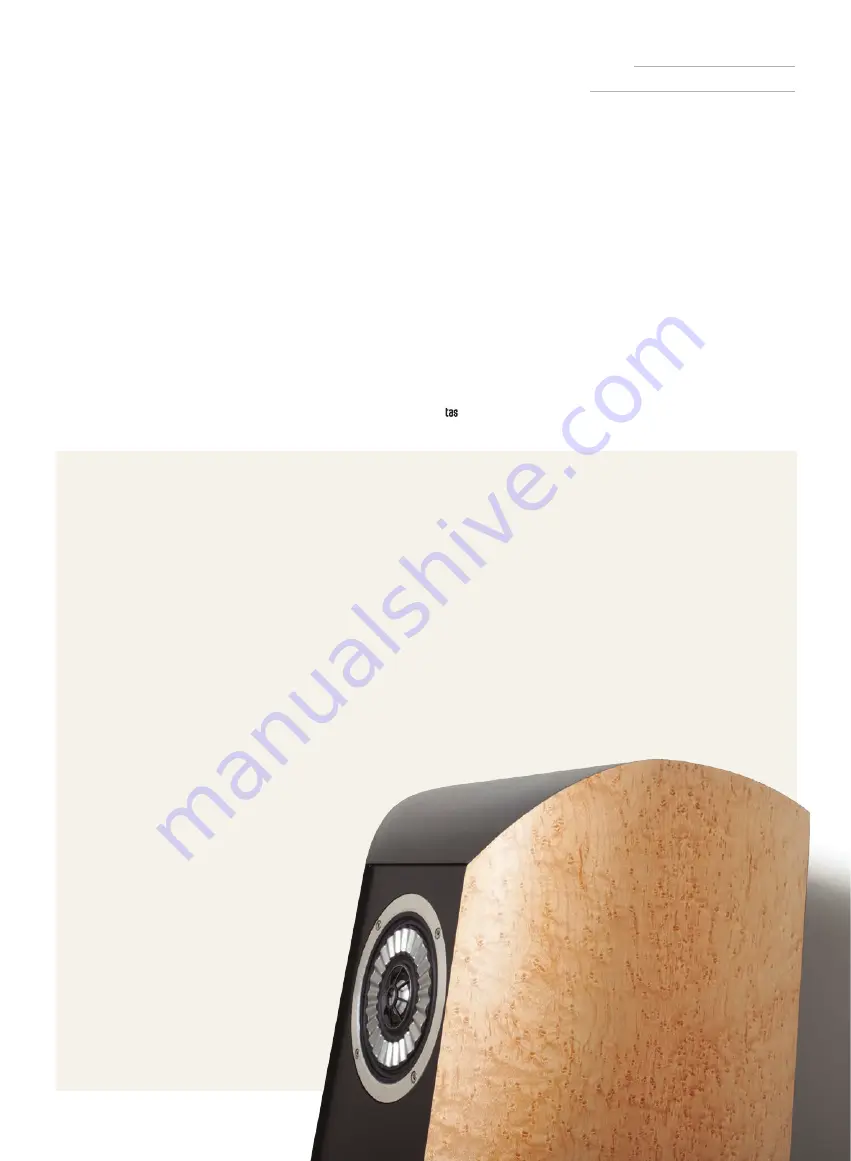
ThIEL Cs2.7
LOudspEAkER
The Coaxial Coincident Driver that is at the heart of the
CS2.7 is the identical unit used in the more expensive
CS3.7. It mounts an aluminum dome tweeter at the center
of a midrange diaphragm, ensuring that the output of
the drivers arrive at the listener’s ears at the same time,
no matter what the listening distance or height. Moreover,
there’s no electrical crossover between the midrange and
tweeter; the tweeter is high-pass filtered mechanically by the
suspension surrounding it. Removing crossover components
from the tweeter signal path has obvious advantages.
Jim Thiel told me several years ago at a CES how he had
conceptualized such a driver and its advantages. When
combined with first-order crossovers, the system would
be time and phase coherent at any listening angle, height,
or distance. Jim thought about the driver for more than
a year, putting off building a prototype because he
believed that he’d need to dedicate six months to a
year to perfecting the driver. He had other, more
pressing, design commitments that required
his attention.
One Saturday, he was overcome with
curiosity and made what he thought would be
the first of dozens and dozens of prototypes.
A couple of hours later, he had, to his great
astonishment, a working prototype that
performed nearly flawlessly. That driver
became the cornerstone of the Thiel line.
What’s remarkable is that Jim had worked
out, purely in his head, every last detail
of the driver’s construction needed to
make it perform as intended. The trial
and error took place in his imagination.
The ribbed aluminum midrange
diaphragm is equally innovative. Jim had been working
with different materials and cone shapes in an effort to
produce the stiffest material with the lowest mass. His
efforts paid off with about a 10% increase in stiffness and a
10% reduction in mass. Most loudspeaker designers would
have been thrilled by this advance and moved the driver
into production. But Jim told me that he asked himself
“Why settle for a 10% increase in stiffness? Why not try for
something with ten times the stiffness?” This inspiration
resulted in the radically different ribbed aluminum
midrange diaphragm of the coincident driver, as well as
the flat ribbed woofers in the CS3.7, which, according to
Thiel, are ten-times stiffer than conventional diaphragms.
—Robert harley
ThE ThIEL COAxIAL COINCIdENT dRIvER
I did, incidentally, get information from Thiel after
I completed the first draft of this review that the 2.7s
take some 300 hours to break-in. This is one hell of a
long practical break-in time. I also found that break-
in did not make a dramatic difference or affect the
issue of timbre I’ve just discussed. The speakers did
seem to get even more transparent and have a slightly
higher degree of midrange warmth with break-in, but
there is no way to exactly compare a speaker with
the 200 hours I’d put on it when I began this review
versus the same speaker at 300 hours when I finished.
Acoustic memory simply is not that accurate.
I would strongly recommend you actually read the
instruction manual. It has unusually good speaker-
placement instructions, and it’s worth spending
serious time experimenting with placement. The Thiel
CS2.7 is not particularly placement-sensitive if kept at
a reasonable distance from room boundaries, but it is far too good to simply
plunk down casually without a long series of efforts to find the best mix of
soundstage, bass, overall timbre, and detail in a given room. I’d also suggest
that if you do hear any initial coloration, you have a placement and not a
speaker problem.
Finally, the Thiel 2.7 works as well with digital room-compensation
systems as any speaker around, and worked very well with the very affordable
DSPeaker Anti-Mode 2.0 Dual Core unit [reviewed by Robert E. Greene in Issue
230]. But don’t push the Thiel 2.7s much below 30Hz, by using too much
bass boost in the lowest frequencies, or equalize them much above 200Hz,
unless you really need to. The speakers already have really good bass for
transducers their size, and trying to turn them into an electronic jukebox is
not going to improve their sound.
Summing Up
One hell of a speaker—and one your wife or partner is likely to be happy
to live with.








